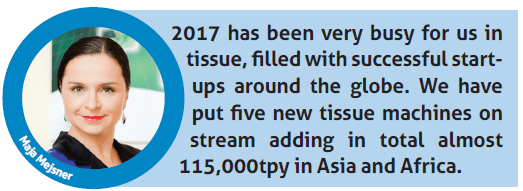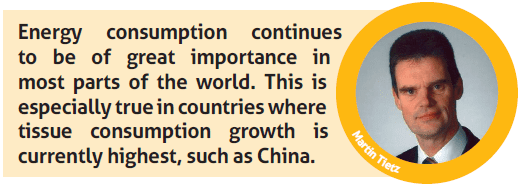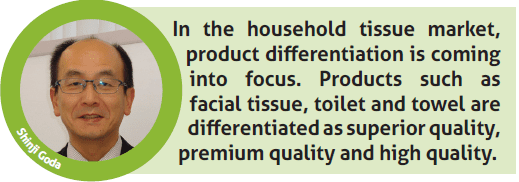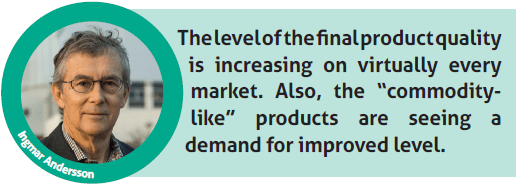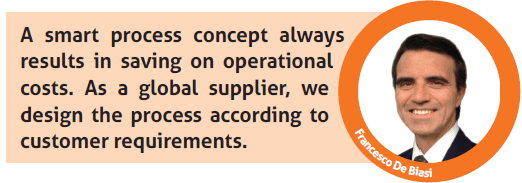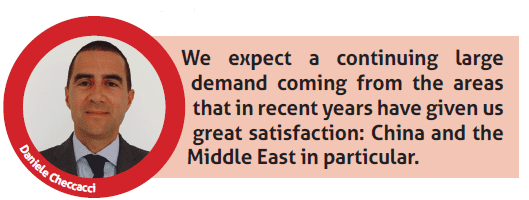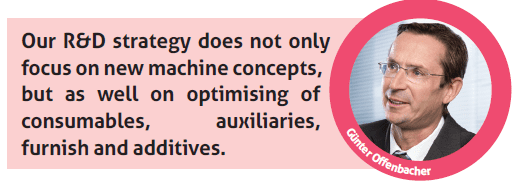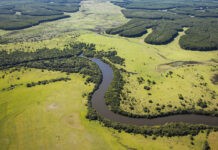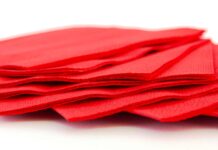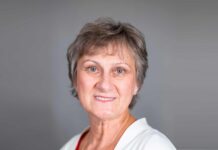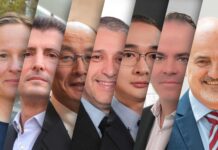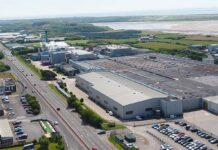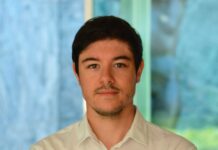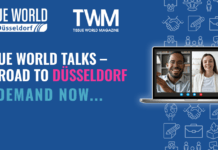Top experts at the world’s leading tissue machinery suppliers detail their assessments of state-of-the-art systems… and explain how they see advances yet to come. A TWM report.
TWM/1: What were your key technical developments during 2017?
Daniele Checcacci, A.Celli Paper, sales manager, EMEA: “The revolution is represented by Industry 4.0, the great process change that affects every industrial sector and that A.Celli has interpreted through a precise vision christened «Extreme Automation».
“The A.Celli Group firmly believes in a production process that uses the new technologies dictated by the Industry 4.0 revolution and that can yield a more immediate and concrete optimisation of production in the individual phases of the process. The most interesting and useful aspect is focused on managing the data acquired, on the possibility of filing for future reference, making them the object of an accurate analysis to transmit predictive machine maintenance programs to operators and to act on the system and eliminate defects or non-conformities. And all this in order to maintain the machine park at a superior level of efficiency/productivity, guaranteeing a better quality of the final product.
“A.Celli’s intent is actually to create a sort of data connector – an ideal passport – that follows the reel of product from its creation during the rewinding phase, throughout the entire process, up to storage and the converting phases.”
Günter Offenbacher, Andritz, director, sales tissue and drying: “Lower energy consumption, more product diversification, investment and operational costs – all these are issues that the tissue producer is facing in his daily life.
“Andritz has reacted to this future challenges and built what we believe is the world’s most modern innovation centre for tissue, the PrimeLine TIAC – Tissue Innovation and Application Centre, so that customers, suppliers and R&D institutes can test and develop tissue solutions for tomorrow. 2017 was the year for Andritz to install this pilot plant in the headquarter in Graz, Austria, and start with pilot trials for new developments in various areas.”
Francesco De Biasi, GapCon, director: “GapCon tissue startedup a new, unique and patented concept of stand-alone shoe press application for tissue in Buenos Aires, Argentina, in the second quarter of 2017.
“EconPRESSTM NExT (New Extended nip concept for Tissue) is the new tool for the tissue manufacturing. The main issues that our customer are facing are still energy and resources saving. GapCon has developed the new tissue machine line EconSOFTTM ERS (Energy and Resources Saving), featuring a high consistency headbox, Steel Yankee Dryer with enhanced stiffness and advanced tissue reel. The Papelera Samseng EconSOFTTM ERS machine has already reached the guaranteed production related to 20,5 g/m2 sheet, with 20% creping factor, reel trim 3,45 m and YD speed of 1.750 m/min.
“The dryness of the sheet entering to the YD features more than 47% at 1,500m/min and almost 46% at 1,750m/min, with operating shoe press linear load set on 200kN/m. The machine is equipped with the YD of dia. 12 foot (3,66m).
“The customer confirmed that he is currently increasing the bulk between 8 – 10% and decreasing the basis weight, with a consequent saving of fibres, getting the same mechanical properties and product quality.”
Shinji Goda, Kawanoe Zoki, director and general manager of engineering: “In the paper industry which is also known as the equipment industry, we have achieved several issues in 2017 as in energy saving for the existing equipment, rebuilds to optimise efficiency and the significant reduction in running cost affected by unstable energy price a number of paper makers are facing.
“We are exploring the possibility of further cost reduction in the tissue making process in order to increase competitiveness among tissue makers together with our customers.”
Maja Mejsner, PMP Group, vice president business development & marketing: “2017 has been very busy for us in tissue, filled with successful start-ups around the globe. We have put five new tissue machines on stream adding in total almost 115,000tpy in Asia and Africa and completed 13 rebuilds in Europe and North America focused on final product quality and/or TM efficiency improvements.
“Compared to our previous experience, we have started up our first turn-key tissue mill for Universal Paper Manufacturers in South Africa (the fifth machine in their fleet that has added 28,000tpy). It was also PMP’s first project in Africa and the first state-of-the-art tissue machine installed in South Africa in the last 20 years.
“On 1 October, the machine reached a production level of 10,000t. We have also installed our first integrated tissue mill with medium size, twin tissue machines (Intelli-Tissue® 1200 EcoEc, 3.65m @reel) for Hebei Jinboshi in China. Both projects were based on a philosophy of Optimum Costs Solutions and a blend of deliveries from our facilities in Poland (PMPoland) and China (PMP IB).
“In the case of both projects, a driving force was achieving premium tissue quality and an impressive return on investment. We helped our customers to fulfil those goals.”
Marco Dalle Piagge, Toscotec, sales director: “The recurring theme is, of course, to reduce energy consumption in tissue production and to improve paper quality, bulk and softness.
“Listening to our customers’ needs, we understand the areas where we have to develop new solutions: we have done it and we are continuing along this track.
“As a result of the ongoing R&D solutions, we now have a new S-Crescent forming area, a dewatering unit on the felt section and a new design on the Pope reel for improved and uniform paper roll winding. Low energy TAD technology is being developed and non-conventional technologies for high bulk paper being tested and ready to run.
“Steel Yankee Dryer is now on third generation phase, and next year will face further improvements, still confidential.”
Ingmar Andersson, Valmet Tissue Mills Business Unit, sales and IPR manager: “Valmet has continued to refine the equipment and operating parameters for Textured Tissue, the Advantage NTT technology.
“The concept is now implemented at most market areas particularly to offer a clear product differentiator for our customers. In particular, the flexibility to swiftly change from one type of product to a completely different, from plain products to textured, has been appreciated.
“This flexibility makes it possible for tissue makers to introduce new and improved products to the market while still being able to make the standard grades. NTT is thereby a risk mitigation for the future demands.”
Martin Tietz, vice president, global product management tissue, Voith Paper: “Energy consumption continues to be of great importance in most parts of the world. This is especially true in countries where tissue consumption growth is currently highest, such as China. Voith provides solutions for reduced energy consumption in tissue production lines.
“Specific optimisation programmes make it possible to reduce the energy consumption of existing tissue machines. Voith has developed a solution for customers that have a surplus of hoods heated with steam. Five machines are already running.”
TWM/2: What changes have you seen in the global tissue market in terms of changes in demand, and what new challenges and opportunities has that presented for paper machine suppliers?
Checcacci: “Based on our experience and on what we were able to measure directly in the field, the market is shifting in a precise direction. Our customers are increasingly placing attention on factors that rotate around the concept of sustainability. Energy savings above all, but not only.
“At the root of the demands is a particular research on “process monitoring” that must be increasingly fine-tuned, and on the “quality of the finished product” that must be superior but with a specific attention on the control of the raw materials (equipping the machines with on-line monitoring systems).”
Offenbacher: “Andritz is acting worldwide in the tissue business and we are implementing new machine projects in all areas of the world with different targets. For example., a new TAD machine project in the USA for premium paper quality. We are supplying a TAD machine with increased performance.
“Increased machine speeds, possible with new patented sheet handling system for TAD paper and secondly with unique tools to reduce machine down-times for fabric changes are some of the new features.
“Furthermore, we are delivering a double-wide tissue machine to South America with an innovative drying concept, single wide machines to Europe and Africa and we are continuing our strong business in China, recently with more new double-wide tissue machines.
“All kinds of machine types and sizes as well as qualities from conventional to premium TAD are requested in the market and. Andritz covers the complete range.”
De Biasi: “In the last year we have seen a relevant increase of entry level tissue machine demand (2.8m paper trim – 50/60tpd average daily production), mainly coming from converters that are planning to produce by themselves their own tissue instead of buying jumbo rolls from the market.
“This resulted in an important market opportunity in terms of potential selling but the business is price driven, so the challenge is to offer the best compromise between machinery price and overall quality.”
Goda: “In the household tissue market, product differentiation is coming into focus. Products such as facial tissue, toilet and towel are differentiated as superior quality, premium quality and high quality. For example, the demand for long toilet rolls (roll length: over 100 metres) has been increasing in Japan.
“Some products have the advantage to be produced with large-size machine and the others with mid-size or small-size machines depending on the demand and user’s preferences. As a tissue machine manufacturer, we should put priority on offering the high efficiency machine specification according to the customer’s needs.”
Mejsner: “Consolidations in a tissue business are even stronger than in the past on a global scale. Large tissue corporations take a lead. They’ve got a number of tissue machines in their fleets and they have a chance to optimise their production and minimise operation costs. In case of new investments, they prefer to add more capacity all at once.
“That is logical, as a process of getting permission to build a single width machine is almost identical with a double width. Taking the last decade into account, the most aggressive players in most cases decided to pick double width machines – especially in mature markets. Well-esteemed players have been also focused on their assets upgrades to optimise production costs. We have provided several projects of that type in the USA for one of the leading tissue corporation.
“In the case of emerging regions, players are more focused on achieving premium tissue quality at ultra-low media consumption costs. We have noticed a huge interest in our product: PMP Intelli-Tissue®EcoEc line (Crescent Former tissue machines, with a 16 feet or larger Steel Yankee Dryer, a large Suction Press Roll of diameter 1,400mm and a steam heated hood).
“The main interests are an extra bulk and a high dryness up to 46%. We are able to achieve the best figures of steam consumption in the market on those machines lower than 1.78 t/t (note: a steam heated hood incorporated). Also in this case, customers decided to go ahead with bigger machines – a medium size: 3.5-3.6m @ reel – we have sold 10 projects of that type in China recently.
“In addition, those projects are executed based on an Integrated Tissue Mill concept (twin machines, one control room, a simplified building with a smaller footprint – no basement). The point is again – a cost optimisation. “I believe we should expect more new larger, lower-cost and more efficient machines. More expansion projects will be observed within existing mills with their own, existing infrastructure – that will help to optimize investment costs.
“Existing producers with older assets will have to think about rebuilds to stay competitive. Smaller ones (with outdated lines) won’t be able to compete any longer and they will be closed.”
Dalle Piagge: “Tissue producers nowadays focus on higher quality tissue and the creation of new products. They are looking at these two main areas to expand their business. We are also witnessing market consolidation in some regions. In such an increasingly tough environment, producers look for the competitive advantage that their core equipment can offer. This is our domain. As tissue machine supplier, we must rise to the challenge by understanding the specific characteristics of a given market and provide the most effective technical solution.
“We are involved in projects from North America to China, Europe, Africa and Latin America: each of them has a specific issue related to energy source, gas availability, energy prices etc. The key of our success is to design the tissue machine according to the market/customer’s need: in a simple word, “customisation” is the solution!”
Andersson: “The level of the final product quality is increasing on virtually every market. World class technology is requested in every market. Also, the “commodity-like” products are seeing a demand for improved level.
“Valmet is now delivering our Advantage DCT concept to all markets following the same high level of standards. Some machines are smaller because of less demand but the tissue products produced are all intended to be the same.” Tietz: “Standard dry-crepe tissue machines are still of great importance in most regions. Here, energy consumption and overall efficiency are important for reducing production costs. Different machine concepts for higher tissue qualities are requested only in selected regions and to a limited extent. They have to cover a wide variety of products and qualities.”
TWM/3: What new challenges do you face in terms of providing energy efficient machines for your customers? How are you dealing with this?
Checcacci: “As partially anticipated, A.Celli intends on tackling the research on the theme of sustainability by entrusting its production processes to technologically evolved, latest generation systems for energy recovery in the process phases (steam – water).”
Offenbacher: “Given by the global requirement to reduce energy consumption and by the pressure to minimise production cost, energy consumption is and will stay a key factor in this business. For the project in South America, we are implementing an innovative drying system, using 100% renewable energy, which is biomass energy.
“The drying section comprises a giant steel Yankee with 22ft and a steam hood, optimised for maximum drying performance and minimised maintenance.
“We have delivered the new PrimePressXT shoe press to the market with advantages of dryness increase, energy reduction and runability improvement. Conventional dry crepe tissue machines are limited with a certain post press dryness (either with single, double or shoe press) by its concept. Andritz has introduced a new machine concept to overcome the limitations of a conventional Crescent Former. This concept will allow for further increase of machine performance and reduction of energy consumption.”
De Biasi: “We are dealing with the supply of energy efficient machinery and also with the need to save fibre and fresh water as much as possible. Our answer to this is our EconSOFTTM ERS tissue line featuring several tools for energy and resources saving. However, machinery is not the exclusive answer: a lean and smart process concept (stock preparation, approach flow, broke management and process water circuit) always results in money saving on operational costs. As a global tissue line supplier, we design the right process according to real customer requirements. Finally, there’re some third part technologies (i.e. vacuum blowers instead of liquid ring pumps) that contribute as well to energy and water consumption decrease in the tissue industry.”
Goda: “In tissue machines, we focus on the press part and the dry part. We foresee the further development of Wide Nip Press and Steel Yankee Dryer technologies in the near future.
“Also, energy recovery is the area that remains to be a challenge and always has space to improve. We are going to offer the equipment adjusted to each part and we believe it can benefit the customers in a great energy recovery.”
Mejsner: “We are observing two trends: energy cost reduction through lowering energy consumption and looking for alternative energy sources. Our efforts are focused on applying robust solutions like large diameters Steel Yankee Dryers (we consequently extend our portfolio in this field following market trends), large diameter suction press rolls and highly efficient hoods.
“In addition, our PMPower division provides smart ideas for existing mills like a new recovery steam generator system from the hood exhaust fumes.
“For instance, at Wepa Lille in France, a recovery energy system allows to save more than 25 % of a steam flow by main generator to the machine and consequently fuel consumption is reduced as well.
Dalle Piagge: “This is a central theme in Toscotec’s approach to new projects. Due to environmental concerns, governments are introducing stricter policies, which have a direct impact on industries in different sectors. The paper industry is no exception.
“At the same time, the cost of energy is rising everywhere in the world. As a result, the first demands of our customers are energy efficiency and energy recovery. For many years now, we have been the pioneer of new solutions that aim at reducing energy consumption and rely on the most cost effective energy sources. For example:
• Toscotec invented and promoted the Steel Yankee Dryer while all our competitors were against it (with no exception!) I clearly remember many speeches and conferences worldwide with our competitors denying the positive results and emphasising the doubts. This is history and today everyone agrees that our invention has become a true innovation. The TT SYD is the reference on the market, the one and only.
• Modern high-speed TM with steam heated hood only. We started in 2010 and our projects have inspired our competitors: some of them now have this solutions in their portfolio. An example of our design in this respect is “Prodergy” (Production meets Energy): big TT SYD diameter 22’ (the biggest Steel Yankee Dryer manufactured so far), with steam heated hood and a record speed of 2,000mpm.
• Regarding top paper quality (structured tissue), TAD is in our range. We also have a project of a TAD machine with steam only, obtaining a significant production cost reduction.”
Andersson: “Energy efficient solutions nowadays are always discussed in conjunction with any request for new capacity from all markets globally.
“Valmet have developed a series of new solutions offered to the market such as ViscoNip Press, ReDry Steam generation, NTT concept, ReTurne energy recovery system, OptiFlo Tis Headbox, ReGen Co-generation of electricity, hot air and steam, Yankee Dryer designs, heat recovery in Yankee hood systems etc.
“If all such inventions would be implemented in the complete line we could offer a line which in practice would operate at about 50% of the standard tissue machine 20 years ago, now about 1,600kWh/tonne total energy for the line.
“However, in practice due to other limitations new investment projects do not allow to implement all technology available but as we find ways to standardise and reduce the cost all these improvements will make its way into our delivery projects.”
Tietz: “Energy efficiency has been important for decades. This has meanwhile spread to most parts of the world. Voith continues to equip machines with low total energy consumption. The entire process is optimised in order to reduce energy demand. In addition, add-on modules are available that further reduce the energy demand as needed.”
TWM/4: What geographical areas do you forecast to have the most tissue growth in 2018 and beyond and why are these areas seeing this?
Checcacci: “We expect a continuing large demand coming from the areas that in recent years have given us great satisfaction: China and the Middle East in particular, but also from Eastern Europe.
“The population density and lower per-capita consumption compared to the standards may be an initial reason, but the truth is that the world’s economic centre of gravity is evolving faster and faster. And we must not forget that A.Celli aims for a worldwide presence. In addition to its Italian facilities, the A.Celli Group is present in Istanbul, Turkey (A.Celli Turchia), in Asia, with a division in Shanghai (A.Celli Shanghai Machinery Co.) and in the Americas, in Concord, NC (A.Celli International).”
Offenbacher: “The highest dynamic growth is still expected to take place in China in 2018.
“Certainly the project activity is reduced compared to the years before due to some overcapacity, but the consumption will continue to grow, mainly based on following the economic growth, and the fact that the average tissue consumption is still at a level with much room to the level we see today in North America or Europe.
“With our strong presence in Foshan, Guangdong province, Andritz is well prepared to fulfil the future market demands in China and Asia. We provide manufacturing capabilities – meanwhile we have manufactured the biggest Steel Yankees ever made in China, two 20ft steel Yankees for double-wide
machines.
“Beside machine delivery, Andritz China does also provide extensive Yankee service to all customers out of our Steel Yankee manufacturing centre in Foshan.”
De Biasi: “The US market is currently one of the more interesting in terms of business opportunities. The market has still some margin of growth in terms of production but the average age of existing machines is quite elevated.
“We see a big potential in rebuilds, looking at headbox replacement (high consistency headbox), forming section rebuild (crescent former instead of fourdrinier), press section retrofit (i.e. EconPRESSTM NExT shoe press installation), drying section efficiency improvement (enhanced heat recovery system in the hood air system, Cast Iron Yankee replacement with steel made cylinders), reel section performance increasing (full width automatic turn-up).”
Goda: “We would say it is Middle East and South East Asia where the growth rate marks high. Tissue demand will increase in these areas with remarkable development due to the awareness of hygiene control.
“Also, even though it is short-term trend, the tissue demand in Tokyo where the Olympics 2020 will take place tends to grow.”
Mejsner: “The tissue sector is healthy and grows at a global scale by almost 4% per year. It is a pretty dynamic market: today China is a leading producer of tissue followed by North America and Western Europe.
“Recently we observe local overcapacity (for example Turkey) caused by active investments.
“On the one hand, the tissue sector attracts investors as hygiene was, is and will be a pillar of an economy and a society needs tissue products so a good ROI is a temptation.
“On the other hand, as overcapacity and a stronger competition decrease margins, costs’ consciousness is crucial.
“Nevertheless, we believe tissue production will grow steadily. According to industry experts, we should expect plus one million tonnes of tissue every year worldwide.
“New trends like closures of unproductive, outdated lines (for instance in China) and potentially conversion projects of newsprint machines (in North America) will become more visible.
“Latin America is in need to grow, however political instability may cool down that process. I strongly believe that emerging economies like Eastern European countries (Russia especially), China and Latin America will show their strength and will shift their tissue production to a higher level soon.
“More mature economies like Western Europe and USA will have to focus more consciously on production costs (through tissue machine upgrades) to stay in a game.
“More and more modern tissue lines have been put on stream bringing high quality products at lower production costs. There is also a huge pressure of private labels against branded products.
“The point is to act smarter rather than harder and find a way to stay competitive.”
Dalle Piagge: “Based on today’s average pro-capita consumption and economy growth, we are still convinced that Asia will have a significant part of the new tissue projects. Consolidation and company acquisitions will help to enhance the performances of the strongest ones and push them to further expand with new projects.
“We also believe that new opportunities will come in mature markets due to product diversification with new non conventional TMs.
“Besides, Europe, Japan and North America have a large number of old machines, which are in need of optimisation and upgrading.”}
Andersson: “The biggest areas of growth will be China. This is because it is the home base of some of the most ambitious investors in this industry and they are fighting for the market position.
“The urbanisation and increase of consumption will cover for some of this expansion but we also think the export will grow and affect also other markets.
“However, the investment pace in China might be slowed down in practice as it seems stricter environmental regulations are being implemented and it takes more time to receive all necessary permits.
“Other markets are more predictable and will grow in accordance with established general growth trends.
Tietz: “Tissue consumption growth in China will remain high due to the economic development. Wealth will allow more households to use tissue products. The installation of new tissue production lines might decline temporarily due to the large recent capacity increase. But overall growth will remain strong.”
TWM/5: How are new paper machine technologies in the market changing your R&D strategies? What key technical areas will you be looking into in 2018?
Checcacci: “A.Celli is poised to provide a dedicated answer based on the different and motley demands of the specific market area.”
Offenbacher: “One tissue machine eight configurations – Andritz TIAC pilot tissue machine offers utmost flexibility.
“We are looking into all areas of future tissue production. Starting from conventional dry crepe machines we will intensify our R&D work into new machine concepts.
“Textured tissue will be one area, bringing together energy efficiency and higher sheet quality. Premium structured tissue (TAD), where wet moulding creates a 3D arrangement of the fibres, preserved by means of air-drying without additional pressing will be another strong focus. However, such premium structured tissue shall be produced with lower energy input in the future, as it is with TAD nowadays.
“Our R&D strategy does not only focus on new machine concepts, but as well on optimising of consumables, auxiliaries, furnish and additives, hand-in-hand with the respective machine concept.
“In these fields, we are working together with innovative product leaders in the tissue industry, who have also contributed to the realisation of the Tissue Innovation and Application Centre.”
De Biasi: “We are working to be an active player in the technological evolution of tissue making. The technical area we’ll look in 2018 is the web formation fibre saving along with process water use reduction, as well as tissue sheet final product quality improvement.
“The focus will be still on energy and resources saving. We have more development ideas in pipeline.”
Goda: “We intend to develop our Former technology further. Former technological innovation contributes to increase the capacity with just small changes in machine designs. This can be applied not only to new machines but also to the rebuilds of existing machines and we believe that this technology is accepted by our customers as it can maximise the capacity with low investment.”
Mejsner: “First of all, we need to adjust our offer to customers depends where they need to act. The most important is to listen carefully.
“A Crescent Former technology (especially our EcoEc line) will still play an important role in the tissue world as this technology is proven and operator-friendly.
“With all extras like multilayer hydraulic headboxes, large Steel Yankee Dryers, a large SPRs (or alternatively a shoe press) it is an optimum concept for emerging economies.
“More mature markets like Western European countries and USA will have to pay more attention to costs. Sounds like structure tissue ideas and utilising a shoe press technology might be an answer.
“We should also remember about upgrades potential. Sometimes changing a headbox only might bring a significant improvement. We are also watching conversion projects (PMP Phoenix Concept® rebuilds).
“We have collected lots of experience within paper side however there are more and more examples of following that trend also in tissue (a profile change from newsprint into tissue) and as PMP we are ready to support our customers.
“I believe that energy will play even more important role in a next couple of months. That is why we are planning to intense our development works of Intelli-Nip® shoe press that is going to be a part of a new line Intelli-Tissue® Ultra to bring even higher dryness and offer more production flexibility in all width TM ratio single, medium and double width machines.”
Dalle Piagge: “Our present and future investments in R&D remain oriented to the reduction of overall energy consumption, with the new challenging target of quality for premium paper grades.
“Recent developments in paper machine technologies are also driving a raised interest of the market in structured paper grades, or at least in sensibly different quality grades in terms of bulk, softness, and other key parameters.
“Toscotec is proposing solutions that make a step ahead in this direction, and in 2018 we will introduce new technological solutions to cover improved conventional machines or structured paper oriented, low energy consuming, TAD machines.
“Industry 4.0 is also the area of our strong interest, being a full control of the process a key factor for process optimization, control, and troubleshooting, making the overall efficiency increase.
“Current and future projects are foreseeing the capability to implement this feature on a partial or full range on the process.
“The latest innovations on Steel Yankee Dryer TT SYD will also be available with important technical achievements that will again be a breakthrough in the market and the benchmark for the next few years.”
Andersson: “We continue to support the development of new improved tissue product quality supporting our customers more competitive on the market.
“In addition, saving fibre material, water and energy is always guiding our R&D as well as the overall stability and reliability of the total process.
“Industrial internet and utilisation of digital solutions is another important part of our future. Valmet is in the forefront of this development and we intend to move forward in this way.”
Tietz: “Voith will continue to develop tissue production technologies for all segments. The R&D strategy has a long term orientation and is not subject to annual changes. New, customized solutions with high efficiency and a low energy demand will remain important. Digitization will be an important tool in achieving this.”
TWM/6: What overall trends in tissue machine manufacture will have the greatest impact on the production process in five years time?
Checcacci: “Producers’ demands are in a continuous quest to rely on stable, repeatable and efficient processes. These factors are at the base of the system defined as the SMART FACTORY and that entails the evolution of the company that has moved on to automated and intelligent systems, operating autonomously and in contact with the surrounding environment.
“A.Celli aims for global integration of the machines, extending its supply to the automatic warehouse of the semifinished product.
“The different areas of the plant are connected by automatic vehicles for reel transport (AGVs) and every single area is equipped with high-quality performance technologies.
“The technological focuses of our system are RFID technology as reel passport and data management on a Cloud platform to share with customers.
“This is why today we no longer consider ourselves mere machine manufacturers, but a centre of excellence and of knowledge, aimed at guaranteeing our customers the best results in terms of performance, innovation, quality and optimisation of investments.”
Offenbacher: “Enhanced machine intelligence of electrification, instrumentation, and automation – we name it PrimeControl E.
“Some examples: Operation will change more and more from the centralised control room to autonomous operation, using mobile devices and augmented reality, where all process and production information is visualised exactly where it is needed.
“Embedded systems, such as drives, QCS, monitoring systems, make sure that all information is made available in one device.
“OPP – Optimisation of Process Performance – is based on smart sensors, big data analysis and augmented reality. KPIs, which are being identified out of process correlations, lead to improvements in productivity and quality, reduction of energy consumption and sustainability of production.”
De Biasi: “Everybody knows that raw fibres and energy accounts for 70% – 75% of the cost of 1 ton of tissue paper. The trend of the next five years will be to produce premium tissue quality with reduced amount of fibre while increasing the overall energy efficiency of the whole tissue plant.
“In addition to that, the trend is to introduce new products and grades in the market (i.e. structured tissue).
“The GapCon latest tissue machine EconSOFTTM ERS design, featuring shoe press EconPRESSTM NExT, opens new relevant scenarios for the production of premium quality tissue paper.”
Goda: “We foresee the machine manufactures that cover total engineering will be most appreciated by the customers. The equipment technology complying with customers’ needs and the training of maintenance technology would be essential. In addition, it is our responsibility to provide working environment to conducive to operators.”
Mejsner: “There are three main drivers that fuel a technological growth in tissue machinery: an energy saving need, a tissue quality improvement and an increase of safety. In addition, there is a need of higher system automation according to a philosophy of Industry 4.0.
“Energy saving solutions are directly connected with an activity especially in the area of a drying section: huge Steel Yankee dryers (up to 20-22 feet), large diameter suction press rolls or shoe presses, highly efficient auxiliary systems (steam and condensate systems, vacuum systems, high-efficient hoods) should be mentioned first.
“The game is to keep the balance between as low as possible media consumption rate (as highest dryness level as possible) and a softness of a product.
“Tissue quality should surprise consumers in a positive way and it varies depends on the region. Mature economies will look for premium softness, whereas emerging markets will compare achieved quality to previous technologies.
“Technologies that guarantee a success are multilayer headboxes (double, triple or even 4 layer type) – Intelli – Jet V®, large diameter suction press rolls or shoe press technology Intelli-Nip®, a vast range of machine clothing and alternative roll covers.
“Finally, safety is of highest importance. A level of staff competences is decreasing so solutions provided within a tissue line should somehow prevent hazardous situations, be user-resistant. The philosophy of Industry 4.0 should help to create a smart factory where data can be easily stored and analysed and processes can be optimized.
“Then best is a chance to practice on virtual model before a user starts to perform in a real situation. We also should not neglect understanding of local market requirements, taking care of good communication with future users (name tags in a local language, periodical safety trainings) and observing daily operations to implement additional protection.”
Dalle Piagge: “Any new technical achievement in the next years will have to be about the increased market demand of premium quality grades, with progressively lower energy need.
“On this path, increased tissue machines efficiency will be key target in a good process design, but also high-quality manufacturing standards and material quality control are requirements not to be missed nowadays for stable operation and reduced downtime needs.
“Process controls, reliable and operator oriented management systems will be essential vehicles to a real efficient operation. With our R&D department, we will be therefore focused not only on equipment, but also on process and controls.
“We have developed proprietary software MCS and DCS for tissue machine and plant process control, and continue on this path to propose newer systems more and more open to Industry 4.0 ongoing achievements.”
Andersson: “Flexibility to meet different market demands in the production process will become more important with the ability to swiftly adjust to market needs in many cases supported by machine intelligence and remote services. Also, the flexibility to respond to different energy sources is becoming increasingly important.
“Different sales and distribution needs will request quick response in the manufacturing and supply chain. Internet of Things will spur this development.”
Tietz: “Digitisation will provide new possibilities for the production process, operating efficiency, machine maintenance, operator training, and much more. Papermaking 4.0 will bring today’s tissue making to a new level.”























